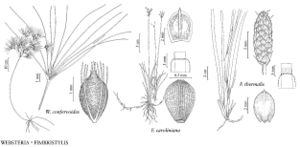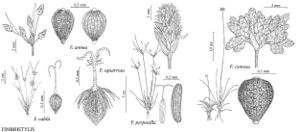Fimbristylis
Enum. Pl. 2: 285. 1805.
Herbs, annual or perennial, usually cespitose, rhizomatous or not. Culms sometimes solitary, scapose, stiff or flaccid, terete, compressed, or 3–5-angled, coarse or fine. Leaves basal, distichous or polystichous; sheaths open apically, shorter than blade, with broad scarious margins; ligule absent at junction with blade or, if present, of erect short hairs, transverse, continuous or interrupted; blades flat or variously folded, terete, or sulcate, not prominently keeled on abaxial surface, the widest not more than 2 mm wide. Inflorescences simple or compound anthelae, rarely capitate; spikelets 1–80+, rarely single; involucral-bracts 2–5, spreading or rarely erect, scalelike or leaflike. Spikelets mainly ovoid to lanceoloid or cylindric, sometimes compressed; scales 8–100+, spirally arranged, each subtending flower or proximal 1–2 empty. Flowers bisexual; perianth absent; stamens 1–3; styles flattened or subterete, 2–3-fid, base enlarged, deciduous. Achenes biconvex or trigonous, reticulate-honeycombed.
Distribution
Worldwide, mostly subtropical and tropical, mostly in sunny, moist to wet places
Discussion
Species well over 100 (16 in the flora).
Culms terminate in scapes; scapes are variously elongate, slender, shallowly to strongly ribbed, overtopping leaves. Leaf blades are mostly linear, compressed or thickened, rarely onefacial. Involucral bracteal blades (more common than scales in Fimbristylis) are linear to setaceous, abbreviated or exceeding inflorescence. Spikelet scales are erect or ascending, rarely nearly distichous; proximal scales sterile, usually bladed, larger than fertile scales; fertile scales mostly uniform, carinate or convex, thin, medially with thicker, longitudinally ribbed band, margins entire; ribs converging apically, often short or longexcurrent. Flowers are protandrous, on short rachilla joint; filaments flattened; anthers bilocular, two- to four-sporangiate; ovary two- to three-carpellate; styles disarticulating at very base, flat, fimbriate, or slender, angular, smooth or papillose. Achenes are tumid, obscurely threeribbed, with faces and angles variously sculpted.
Selected References
None.
Lower Taxa
Key
| 1 | Styles 3-fid; plants annual. | > 2 |
| 1 | Styles 2-fid; plants annual or perennial. | > 3 |
| 2 | Ligule of short hairs present; leaf blades flat; spikelets mostly narrow, narrowly lanceoloid to narrowly ellipsoid. | Fimbristylis autumnalis |
| 2 | Ligule not evident; leaf blades strongly folded, bifacial; spikelets plump, broadly ovoid. | Fimbristylis miliacea |
| 3 | Ligule of short hairs absent or incomplete. | > 4 |
| 3 | Ligule of short hairs evident and complete (most noticeable in plants having broadly linear leaf blade base, harder to detect in narrower, more involute or adaxially sulcate leaf blades). | > 9 |
| 4 | Plants low, usually less than 20 cm (F. squarrosa 30 cm or more), often densely tufted, slender, weedy annuals; leaf blades linear-filiform, to 1 mm wide. | > 5 |
| 4 | Plants tall, usually (20–)30–150(–200) cm, more robust, densely to sparsely tufted perennials; leaf blades 1+ mm wide. | > 7 |
| 5 | Spikelets ovoid; achenes cylindric. | Fimbristylis perpusilla |
| 5 | Spikelets lance cylindric; achenes obovoid, biconvex. | > 6 |
| 6 | Spikelets sessile or subsessile in dense, terminal, headlike cluster; base of style smooth or papillate. | Fimbristylis vahlii |
| 6 | Spikelets in open anthelae; base of style with slender, recurved fimbriae covering achene summit. | Fimbristylis squarrosa |
| 7 | Spikelets less than 5 mm, in headlike or dense clusters; apex of fertile scales rounded, mostly notched, midrib not exserted; leaf blades shallowly concave or flat; achenes tumid. | Fimbristylis cymosa |
| 7 | Spikelets usually more than 5 mm, mostly in more diffuse clusters; apex of fertile scales rounded, sometimes ciliolate, midrib reaching tip or excurrent as mucro; leaf blades mostly strongly involute; achenes lenticular. | > 8 |
| 8 | Plants densely cespitose; bases of leaves hard, leathery, usually dark brown or castaneous. | Fimbristylis castanea |
| 8 | Plants loosely cespitose in small tufts or culms solitary; bases of leaves not as above. | Fimbristylis puberula |
| 9 | Rhizomes slender, elongate; robust perennials with wandlike culms, at least 50 cm. | > 10 |
| 9 | Rhizomes absent or, if present, stout, strongly tapering or made up of thickened contiguous culm bases; annuals or perennials infrequently exceeding 50 cm, mostly under 40 cm. | > 12 |
| 10 | Spikelets lance-ovoid to cylindric-ellipsoid; scales with abaxial surface dull, uniformly puberulent, scale apex broadly acute, midrib excurrent as mucro or cusp. | Fimbristylis thermalis |
| 10 | Spikelets ovoid to lance-ovoid, rarely cylindric, scales with abaxial surface lustrous, glabrous or puberulent apically, scale apex abruptly rounded, midrib excurrent as mucro. | > 11 |
| 11 | Fertile scales puberulent apically; scapes broadly linear, distally flattened or oval, edges usually scabrid; achene finely but definitely cancellate. | Fimbristylis caroliniana |
| 11 | Fertile scales glabrous; scapes narrowly linear, distally angular, glabrous; achene nearly smooth or with longitudinal rows of shallow, isodiametric pits. | Fimbristylis puberula |
| 12 | Spikelets pale (stramineous on herbarium specimens, pale red-brown on living plants), usually solitary on scape, infrequently in anthela of 2–3; achenes appearing smooth under 10–20X magnification, under higher power showing fine longitudinal rows of shallow isodiametric pits. | Fimbristylis schoenoides |
| 12 | Spikelets dark, usually in open or congested multispikeleted anthelae; achenes appearing smooth, finely striate, or coarsely reticulate on face. | > 13 |
| 13 | Face (1 side) of achene smoothish or with many (20 or more) longitudinal rows of shallow pits or cells, thus finely striate; annual. | Fimbristylis tomentosa |
| 13 | Face (1 side) of achene more coarsely reticulate, usually with 12 or fewer longitudinal rows of horizontally oriented, rectangular cells; annual or perennial. | > 14 |
| 14 | Plants perennial; achenes without warts. | > 15 |
| 14 | Plants annual; achenes variably warty. | > 16 |
| 15 | Plant base bulbous, also scaly-rhizomatous; spikelet scales glabrous or puberulent. | Fimbristylis brevivaginata |
| 15 | Plant base not bulbous, not producing rhizomes; spikelet scales glabrous. | Fimbristylis dichotoma |
| 16 | Leaf blades hirsute-ciliate at least proximally; warts present only at apex of achene margin. | Fimbristylis decipiens |
| 16 | Leaf blades uniformly smooth to scabrid or ciliolate at margin; warts of achene usually distributed, or rarely achenes smooth. | Fimbristylis annua |
"shortened" is not a number.


